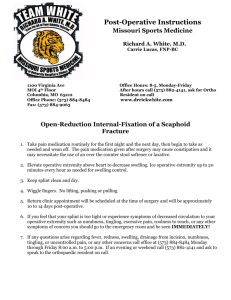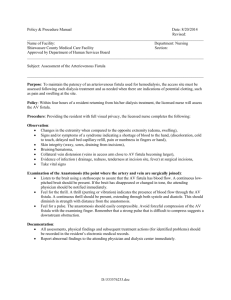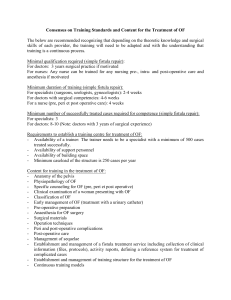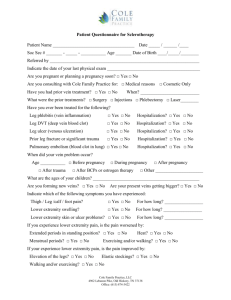protocol: AV Shunt or Fistula, (PACU)
advertisement
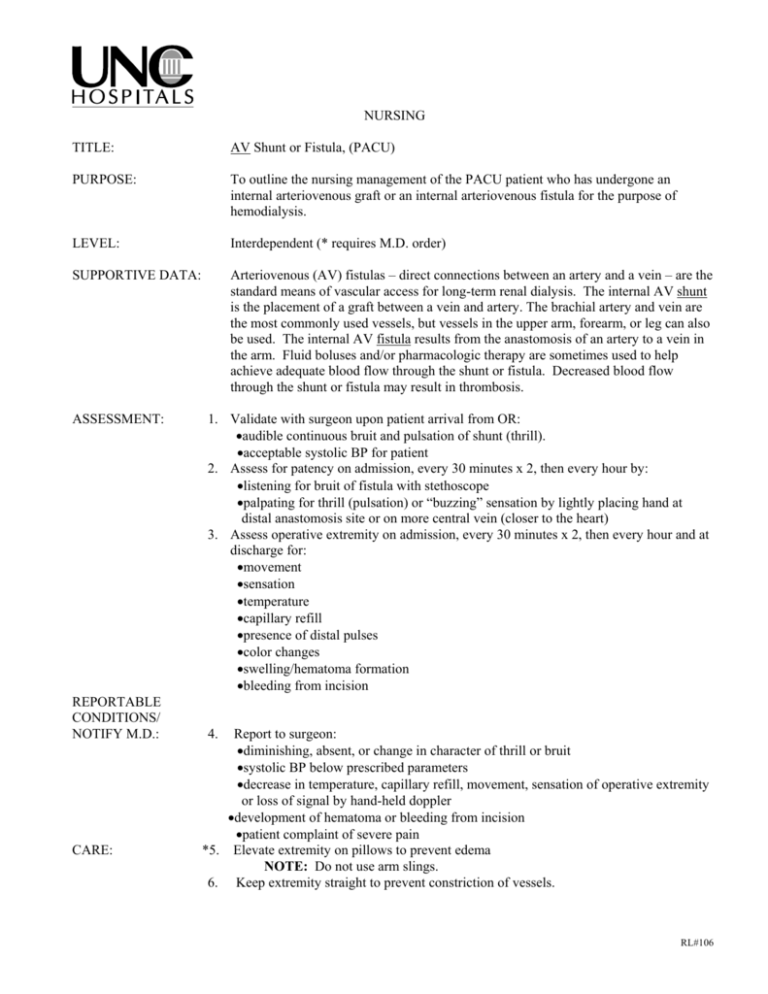
NURSING TITLE: AV Shunt or Fistula, (PACU) PURPOSE: To outline the nursing management of the PACU patient who has undergone an internal arteriovenous graft or an internal arteriovenous fistula for the purpose of hemodialysis. LEVEL: Interdependent (* requires M.D. order) SUPPORTIVE DATA: Arteriovenous (AV) fistulas – direct connections between an artery and a vein – are the standard means of vascular access for long-term renal dialysis. The internal AV shunt is the placement of a graft between a vein and artery. The brachial artery and vein are the most commonly used vessels, but vessels in the upper arm, forearm, or leg can also be used. The internal AV fistula results from the anastomosis of an artery to a vein in the arm. Fluid boluses and/or pharmacologic therapy are sometimes used to help achieve adequate blood flow through the shunt or fistula. Decreased blood flow through the shunt or fistula may result in thrombosis. ASSESSMENT: REPORTABLE CONDITIONS/ NOTIFY M.D.: CARE: 1. Validate with surgeon upon patient arrival from OR: •audible continuous bruit and pulsation of shunt (thrill). •acceptable systolic BP for patient 2. Assess for patency on admission, every 30 minutes x 2, then every hour by: •listening for bruit of fistula with stethoscope •palpating for thrill (pulsation) or “buzzing” sensation by lightly placing hand at distal anastomosis site or on more central vein (closer to the heart) 3. Assess operative extremity on admission, every 30 minutes x 2, then every hour and at discharge for: •movement •sensation •temperature •capillary refill •presence of distal pulses •color changes •swelling/hematoma formation •bleeding from incision 4. Report to surgeon: •diminishing, absent, or change in character of thrill or bruit •systolic BP below prescribed parameters •decrease in temperature, capillary refill, movement, sensation of operative extremity or loss of signal by hand-held doppler •development of hematoma or bleeding from incision •patient complaint of severe pain *5. Elevate extremity on pillows to prevent edema NOTE: Do not use arm slings. 6. Keep extremity straight to prevent constriction of vessels. RL#106 AV Shunt or Fistula, (PACU) UNC HOSPITALS, Nursing 2 ADMINISTRATION: *7. Administer fluid bolus to maintain BP within ordered parameters. *8. Administer vasopressor medication (usually phenylephrine) IV to maintain BP within ordered parameters. NOTE: Wean off medication as soon as possible. SAFETY: 9. Keep operative site within view until sensation returns if done under a nerve block. PATIENT/CAREGIVER TEACHING: 10. Instruct patient/caregiver to protect operative extremity for the first two hours after surgery by keeping extremity: •elevated •visible •straight •non-constricted or compressed 11. Instruct patient to notify nurse of any decrease in sensation or motion of operative extremity. 12. Instruct patient/caregiver to protect operative extremity during sleep by not lying on it. 13. Instruct patient/caregiver to inform nurse of increased swelling, pain or incisional changes. 14. Instruct patient/caregiver not to permit blood pressure measurement or venipuncture in operative extremity. DOCUMENTATION: 15 Document on Progress Notes, Patient Care Record/flowsheet or electronic form: •implementation of AV Shunt or Fistula (PACU) •assessment findings •interventions and patient responses/outcomes •reported conditions •patient/caregiver teaching and level of understanding REFERENCE: PeriAnesthesia Nursing Core Curriculum, Preoperative, Phase I, and Phase II PACU Nursing, Donna M. DeFazio Quinn and Lois Schick, 2004, WB Saunders Co. Alexander’s Care of the Patient in Surgery, 12th Edition, J. C. Rothrock, 2003, Mosby, Inc. APPROVAL: Nursing Standards Committee EXTERNAL REVIEW: Dr. Laurie Lilley, Chief Resident, Vascular Surgery REVISED: Distribution: Date: Date: 3/17/92 09/25/95 11/21/95 11/17/98 12/18/01 04/19/05 Surgical Services CLINICAL DIRECTOR: Susan Phillips RL#106
